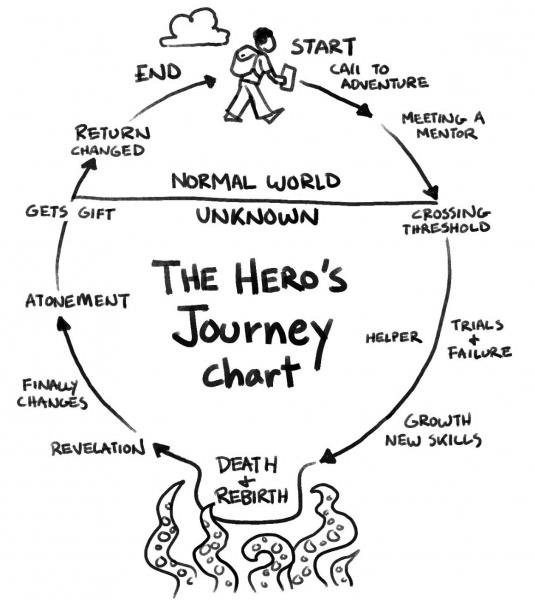Introduction to Cinema Therapy
I developed a method called cinema alchemy and what I do is have three approaches: the evocative way, the prescriptive way, and the cathartic way. So, this is a whole concept.

In today's article, I want to introduce Cinema Therapy. And here, I would like to borrow Dr. Birgit Wolz's talks to give a brief introduction to how Cinema Therapy work. And I will also talk about The Hero’s Journey, one of the fundamental narrative frameworks that can be used in cinema therapy and even in everyone's life.
Dr. Birgit Wolz: I developed a method called cinema alchemy and what I do is have three approaches: the evocative way, the prescriptive way, and the cathartic way. So, this is a whole concept.
The evocative way is using movies like dreams, an entryway into our subconscious. So, whenever somebody comes in and says I saw this movie and it really touched me. I go with that and I explore deeper and then deeper layers of why this touched them.
The prescriptive way is I have a certain goal to work with a client. For example, what were addiction and couple’s work? I prescribe a certain movie that helps them understand their condition and maybe breaks some denial or understanding with couples who learn communication. And I ask them how this movie worked or what they think the movie could help them with or what turns them off, what they do already, what could they learn from it, things like that.
The cathartic way is pretty self-explanatory. To watch movies that make people laugh or cry, so their hormones and the new transmitters get triggered in a way. It’s important that the client chooses the movie because I don’t know what makes them laugh. There is a list of movies on my cinema therapy website, they can choose what they have seen it made them laugh before, and most likely it would make them laugh again.
The mythological hero’s journey is a pattern for most movies. So the hero first hesitates to take on the challenge then he takes it on, and it goes to all these challenges and obstacles and fights the demons, and then comes out renewed. When we follow that and I guide my clients to follow this hero journey. I am using hypnotherapy in this case. In a movie, like our lives, they become the character and they move through it, and in that way, it helps them apply the situation to their own and gain strength and confidence.

The Hero’s Journey is one of the fundamental narrative frameworks that the Cinema industry exploits in their work. Joseph Campbell, an American Mythologist came up with a pattern of how the typical adventure of an archetype, The Hero, takes place. He argued that there’s a commonality in the way different mythologies have shaped with time. The adventure or the journey that he so describes is now used generously in drama, storytelling, myth, religious ritual, and psychological development. Inherently, every Hero’s Journey is divided into the following 3 stages: Separation, Initiation, and Return. These are further divided into more specific stages that happen universally in every story.
As I thought more and more about this, I started applying this to every aspect of my own life. Every so-called hurdle would become a threshold that I would want to cross with the help of some of the existing tools; just like the Light Saber that Obi Van Kanobi gives to Luke in Star Wars. I’d accept the call, go through my road of trials and face the abyss too. Then during the journey, I’d develop new skills to overcome that hurdle, enter a new world, and experience atonement. And then there, lies my reward.
I was deeply fascinated by the concept and suddenly all the different stories, events in history, and mathematical theories: all started to show up this pattern. Having deliberated so much, more than finding it amusing, I started seeing the beauty in it. Every problem became an opportunity of going through this journey and experiencing the satisfaction of atonement. It really changed my perception about a lot of things and I started taking advantage in both my personal and professional life.
